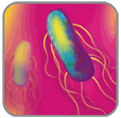
Salmonella

Listeria monocytogenes
Members of the genus Listeria are ubiquitous and only one species is pathogenic. Listeria have been isolated from various food products including dairy products, meat, vegetables, and seafood, as well as from environmental samples taken, in particular, from food processing plants.
Listeria monocytogenes is the only species considered as pathogenic for humans. Listeriosis in humans may cause pathologies such as meningitis, septicaemia, encephalitis and abortions.
Groups at risk include pregnant women, neonates, immunocompromised patients, and the elderly. Listeria monocytogenes is widespread in the environment and is a potential risk when raw, partially processed and even some fermented food are consumed.
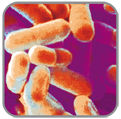
Listeria spp.
Members of the genus Listeria are ubiquitous and only one species is pathogenic. Listeria have been isolated from various food products including dairy products, meat, vegetables, and seafood, as well as from environmental samples taken, in particular, from food processing plants.
Listeria monocytogenes is the only species considered as pathogenic for humans. Listeriosis in humans may cause pathologies such as meningitis, septicaemia, encephalitis and abortions.
Groups at risk include pregnant women, neonates, immunocompromised patients, and the elderly. Listeria monocytogenes is widespread in the environment and is a potential risk when raw, partially processed and even some fermented food are consumed.
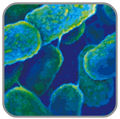
E.coli O157:H7
he severity of Escherichia. coli O157:H7-induced infection, generally caused by the consumption of contaminated meat or milk, is now well-established.
Standard food hygiene and storage precautions are frequently not enough to limit the presence of this micro organism.
Screening for this pathogen is now more important than ever.

E.coli

Coliforms
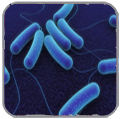
Enterobacteriaceae
Increasing emphasis on a total quality approach in food production, HACCP plans and Risk Assessment procedures enhance the role that quality indicators such as Total Viable Count, Coliforms, Escherichia coli and Enterobacteriaceae have in monitoring the hygienic and commercial quality of food.
Enterobacteriaceae enumeration is the key hygiene parameter in the latest European regulation on microbiological criteria for food, EC 2073/2005.
The Enterobacteriaceae family includes important food spoilage agents and certain intestinal pathogens such as Salmonella spp., Shigella spp…
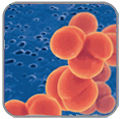
Staphylococcal enterotoxins

Staphylococcus
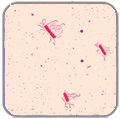
Bacillus cereus

Cronobacter
Increasing emphasis on a total quality approach in food production, HACCP plans and Risk Assessment procedures enhance the role that quality indicators such as Total Viable Count, Coliforms, Escherichia coli and Enterobacteriaceae have in monitoring the hygienic and commercial quality of food.
Enterobacteriaceae enumeration is the key hygiene parameter in the latest European regulation on microbiological criteria for food, EC 2073/2005. The Enterobacteriaceae family includes important food spoilage agents and certain intestinal pathogens such as Salmonella spp., Shigella spp…
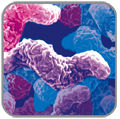
Campylobacter
The number of enteric infections caused by Campylobacter genus - and Campylobacter jejuni (thermo tolerant bacterium) in particular - has been rising rapidly ever since many countries set up monitoring systems.
The complications related to these infections - bacteraemia, secondary infections and Guillain-Barré syndrome (neurological complication) - are now well documented and can be particularly severe.
Campylobacter is the third cause of death from food borne infections after Salmonella and Listeria.
Campylobacter is found primarily in warm-blooded animals, particularly poultry. Transmission to humans usually occurs through eating insufficiently cooked contaminated foods (poultry, mutton, pork) and exposure to contaminated water and environments in food production facilities and animal breeding facilities (primarily poultry farms).
The frequent presence and high level of Campylobacter in such samples, the lack of regulations in most countries and the complex analyses required are all factors that have, until now, hampered routine screening.

Legionella
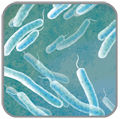
Vibrio

Virus
Viral food-borne illnesses
Viral foodborne illnesses are caused by different viruses, which potentially contaminate foods, at all stages of the food supply chain, as well as the environment.
The leading cause of gastroenteritis, food-borne viral infections are primarily due to two main viruses : norovirus which causes gastroenteritis and Hepatitis A virus which causes hepatitis A. Human excrete the viruses (feco-oral route) and food contamination occurs either from an infected food handler during preparation (GHP), from contaminated water (GAP), typically during primary production. Symptoms are typically nausea, vomiting, diarrhoea and abdominal pain. Viral food-borne outbreaks are mostly caused by Norovirus.
What are enteric viruses?
Viruses are infectious microorganisms, with DNA or RNA genome enclosed in a protein coat. Unlike bacteria, viruses can only multiply inside living cells of other organisms. Many viruses resist to stresses such as heat, drying, freezing, UV light, High Pressure and survive for long periods of time in foods or the environment.
What are the most frequent viruses in viral outbreak ?
The majority of viral foodborne illnesses are caused by those viruses : Norovirus Gi & Norovirus GII, Hepatitis A virus and Hepatitis E virus, Rotavirus (for Children), but not limited to them. Enterovirus, Sapovirus, Astrovirus are also described in the scientific literature.
Foods associated with viral food-borne illnesses
Food associated with viral food-borne illnesses are bivalve Shellfish (Oysters, mussels, cockles, scallops, etc), Fruits (strawberries, raspberries, goji berries, dates, tomatoes, etc), vegetables in the form of leafy greens (spinach, lettuce, herbs, etc), pork and game meat (figatellu, etc), Ready-to-eat.
Detection of Viruses in Food and Environmental Samples?
Viruses cannot be cultured, unlike bacteria. Enrichment is not possible. Molecular techniques are the methods of choice for the detection, identification and quantification of foodborne viruses. The ISO/TS 15216-1&2 Standard covers most pre-treatment steps to elute viruses from the different matrices, specifically for Norovirus and hepatitis A Virus.

